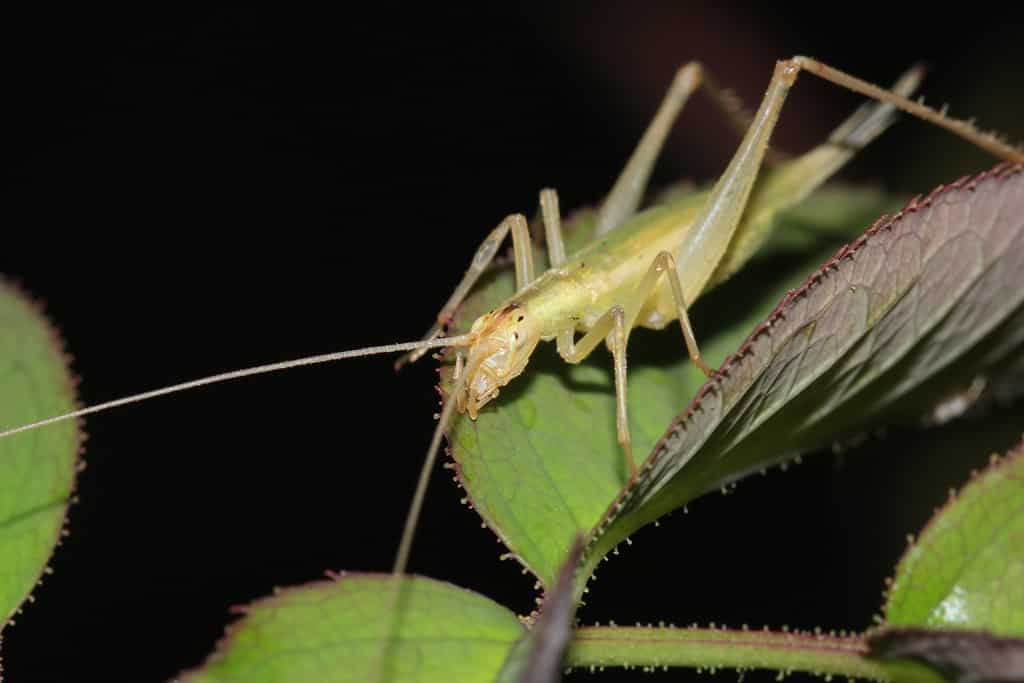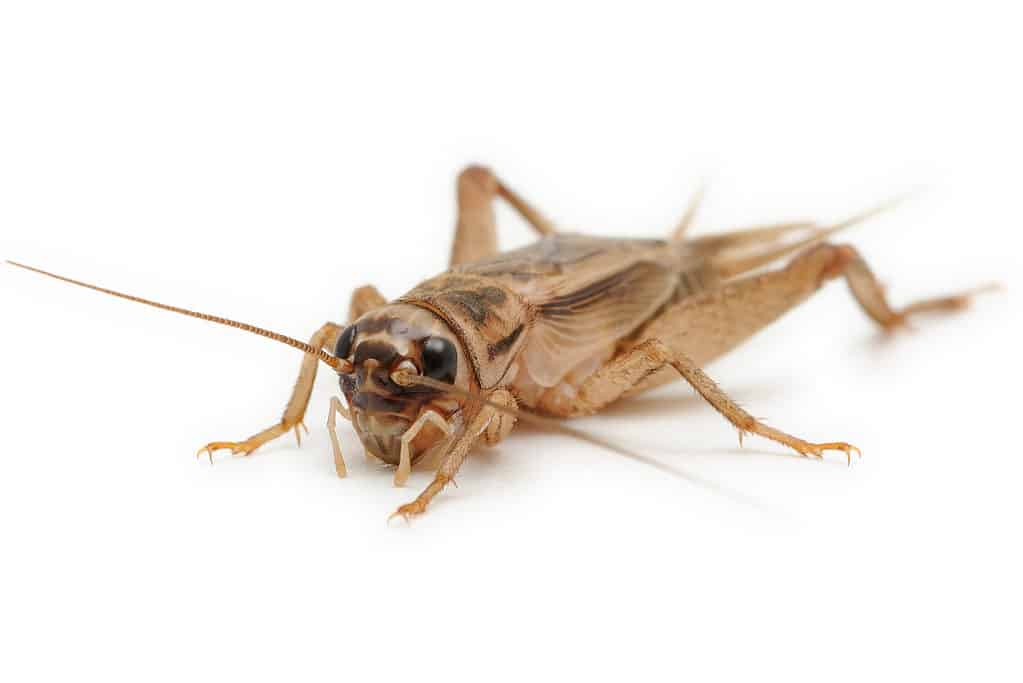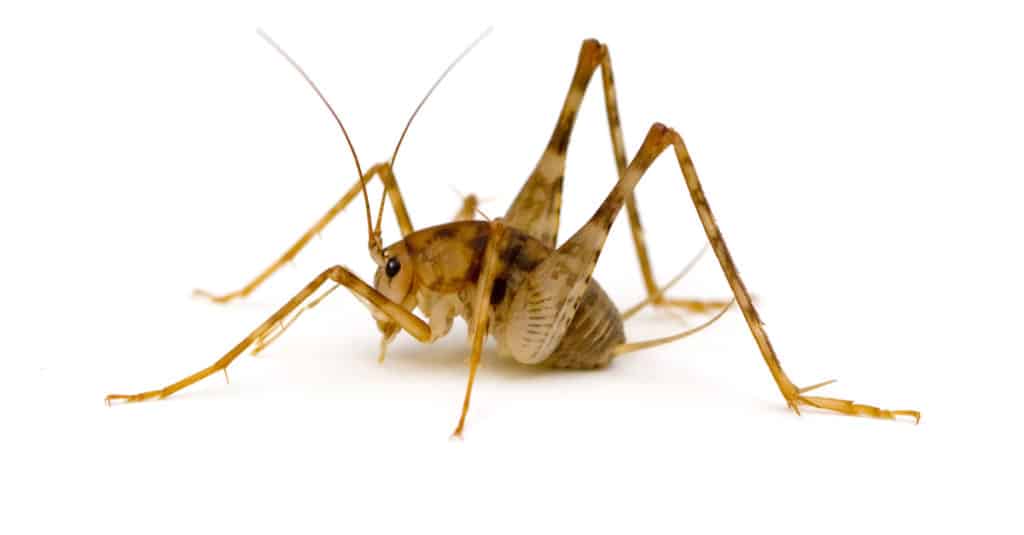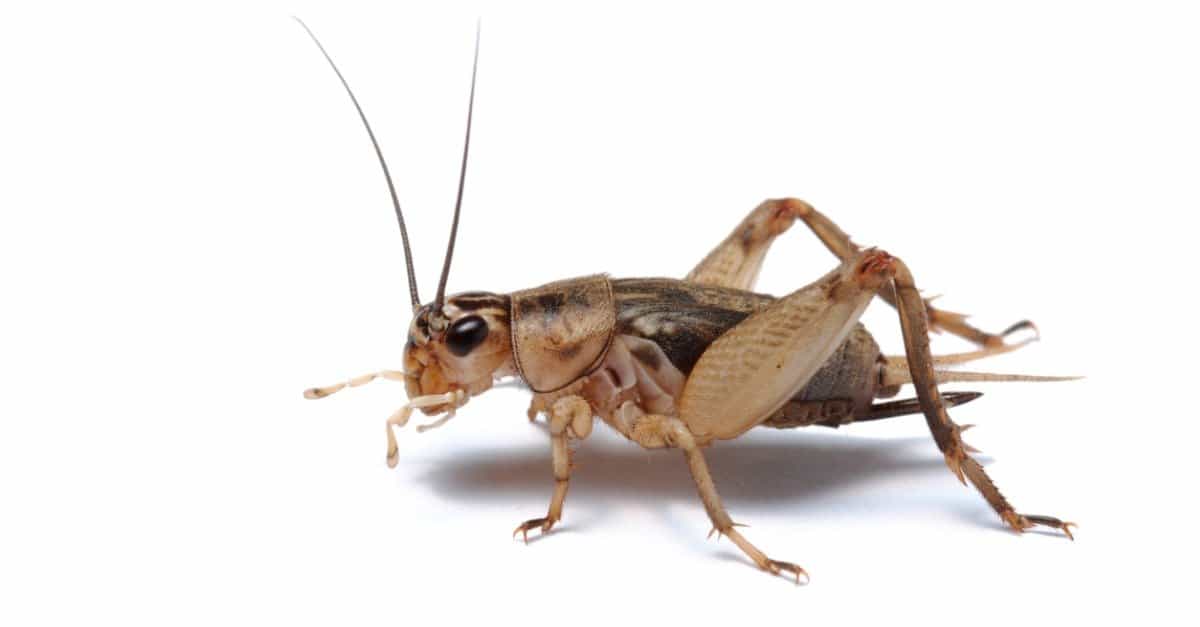Have you ever heard the sound of crickets chirping and wondered what it means? This article will explore why crickets chirp and the science behind it.
About Crickets

Oecanthus fultoni, or snowy tree cricket, is common in North America.
©RECEP_OZTURK/Shutterstock.com
Crickets are small insects belonging to the family Gryllidae. They typically have long antennae, large hind legs for jumping, and two sets of wings. Crickets live in many parts of the world and make their homes in various habitats, such as grasslands, forests, and even urban areas.
There are over 900 species of crickets worldwide. They come in a variety of colors, sizes, and shapes, with some species being larger than others. Crickets are nocturnal animals, which means they are most active at night. And that is when we hear their characteristic chirping sound – but why do they make this noise?
7 Reasons Why Crickets Chirp

One of the reasons why crickets chirp is to attract a female mate.
©iStock.com/Triggermouse
Have you ever sat outside in the evening and heard the sound of crickets chirping? It’s a very familiar and pleasant sound that can often be heard during the summer months. Let’s dive deeper into why crickets chirp.
1. Calling Song
The calling song of crickets is a sound that attracts female crickets and repels other males. It is quite loud and can be heard even in the dead of night. The song is made up of a series of chirps and clicks and is unique to each species of cricket. This song is different from the courting song. It is like a duel between two males. The cricket who wins this chirping duel, wins the girl.
The sound of the calling song of crickets is often described as a musical sound as if the crickets are singing a melody. This melody is made by rubbing the wings of the cricket together and can be heard from up to a half mile away.
The sound of the calling song can be quite loud, depending on the species of cricket. It is also an important part of the nocturnal environment, providing a pleasant sound in the night air.
2. Courting Song
A gentle summer night is often filled with the song of crickets. This melody is known as the courting song of crickets, and it is used by male crickets to attract a female. The sound of the chirping is produced by rubbing their wings together and attracts the female cricket to come closer.
The courting song of crickets is a distinct sound that differs from the usual chirping heard during the day. It is much louder and more intense and designed to capture the attention of any female cricket in the area. It is also often accompanied by the male cricket performing a sort of dance to attract the female.
Once the female cricket has been attracted, she will often respond by chirping in a manner similar to the male’s song. This is her way of saying she is interested in mating. If the male is lucky, the female will come closer, and mating can begin.
The courting song of crickets is a beautiful and unique part of nature. It is a reminder that even in the smallest creatures, there is a desire for connection and love. It is a symbol of hope that love will always prevail.
3. Triumphal Song

Another reason why crickets chirp is to chase off other male competition.
©iStock.com/Florian DENIS
The sound of crickets is a familiar one in the summertime. But for a brief period after a successful mating, these small creatures produce a special, triumphant song. This song serves to reinforce the mating bond between the two, encouraging the female to lay her eggs with the same partner rather than seek out another male.
The sound of the crickets’ triumphant song is a beautiful one, a reminder of the success and joy of the mating ritual. It is a strong, clear sound, distinct from the more gentle chirps heard throughout the warm summer months. It is a sound of joy and celebration, of triumph and success.
The song of the cricket is a reminder of the great power of nature. It is a beautiful reminder of the success of the natural order, of the incredible mating ritual between two small creatures.
4. Aggressive Song
The aggressive song of crickets is an incredible sound, one that is triggered by contact chemoreceptors on the antennae that detect the presence of another male cricket. If the male comes close, a battle for dominance begins. The two males will attempt to establish dominance over each other by aggressive behavior, lashing out with their antennae and extending their mandibles.
The song is a series of chirps created by the male rubbing their wings together. You can hear the sound from a great distance, warning other males that they are approaching the territory of another cricket.
It is a fascinating display of aggressive behavior that helps the males establish dominance. It is a reminder of the power of sound and the importance of communication in the animal kingdom.
5. Fight Song
If one of the male crickets does not run away or retreat after hearing the aggressive song, a physical fight will ensue. They will wrestle with each other, making a unique loud call that they only make during fights.
While fighting, the crickets will use their long legs and antennae to grab each other. They may also strike out with their mandibles in an attempt to gain dominance over the other cricket. The winner of this fight is usually declared when one of the males backs down or runs away from the area.
The Fight Song is a reminder that communication can be used not only for courtship but also as a form of aggression. It serves as an interesting example of how sound can be used to convey specific messages in the animal kingdom.
6. Victory Song

One of the reasons why crickets chirp is in victory when they win a fight.
©Melinda Fawver/Shutterstock.com
When one of the male crickets wins the fight, he will sing very loudly, and the other cricket will retreat silently, not making a peep.
This loud victory song of the winner is a reminder to other potential challengers that he has won the fight and should not be challenged. It also serves as an advertisement for any female crickets in the area, indicating that this male cricket is strong enough to protect them and their eggs from predators.
7. Temperature Song
Different types of crickets sing at various speeds depending on what species they are and the temperature of the atmosphere. Generally, the hotter it is, the faster it chirps. The speed is around 62 times a minute at 55°F, but there is variability among species. This relationship is referred to as Dolbear’s law. Here is an example of how to use this law. To get an estimate of the temperature in Fahrenheit, you can count how many times a snowy tree cricket chirps in 14 seconds and then add 40.
How Do Crickets Chirp?
Crickets are small insects that make a distinct chirping noise that is often associated with summer nights. But how exactly do crickets produce this sound?
When a cricket chirps, it rubs its wings together to create a sound. In particular, it rubs the outer edge of one wing against a special structure called the “file” on the other wing. This file is a series of ridges and teeth that are used to create the chirping sound.
The cricket’s wings are controlled by a set of muscles. By contracting and relaxing these muscles, the cricket is able to produce a sound that can be heard up to several hundred meters away.
The rate at which a cricket chirps depends on the temperature. In cooler weather, the cricket’s muscles can contract more slowly, resulting in a slower chirp. Conversely, when the temperature is higher, the cricket’s muscles contract faster, resulting in a faster chirp.
In addition to the temperature, the amount of light also affects the rate at which a cricket chirps. When it is dark, a cricket will chirp more slowly, while in bright light, it will chirp more quickly.
Crickets are incredible creatures that have adapted to their environment in order to survive. Through the use of their wings, they are able to create a distinct chirping sound that can be heard from quite a distance. By understanding the mechanisms behind their chirping, we can appreciate the complexity of their behavior even more.
Thank you for reading! Have some feedback for us? Contact the AZ Animals editorial team.








